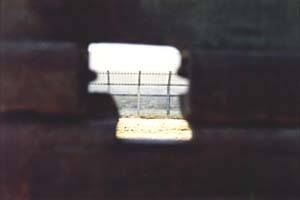|
When I got the chance I traveled south to the border and landed in Tijuana, where I interned for two months with a local Mexican non-profit organization called Esperanza. I found many of the answers I was looking for. The journey begins with you and me. With an awareness of our own ignorance of the lives of our neighbors, of their welfare and of their future, we take the first steps toward closing the gap and opening the door to a new future. All of the following photographs were taken in the summer of 1999, mainly in Tijuana, Mexico. If you are interested in finding out more information and seeing what you can do to close the information gap, get involved in local and international development efforts, or visit for yourselves, please contact me at rachaelrapp@hotmail.com, or espranza@telnor.net. Thank you. The following images were on exhibit at the Evergreen Library, CO, October 1-30, 2001. |
||
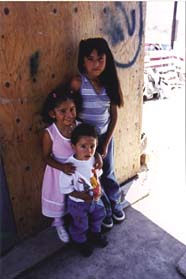 |
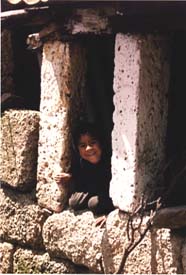 |
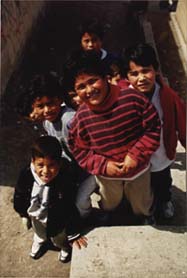 |
On Sunday Antonieta showed me la linia and el bordo for the first time, the physical wall that the US constructed on the border to deter illegal migration. A lot of the metal used for the wall is left over from the air landing platforms the US army had to create in the desert during the Gulf War. It keeps going and going, we followed it right to the sea. The border patrol (la patrulla fronteriza) always has a car parked right on the other side. In many places the walls are doubled in height, stretching a good 20 feet, and there is more than one wall to cross in various sections, the second one being much more difficult. We saw some pollos (border-crossers) on one side of the wall hiding out for their chance, they couldn't see it, but at the time there were four patrol cars just on the other side.
In the winter of 1994, the US passed a law called Operativo Guardian ("Operation Gatekeeper"), which intensified the patrolling of the wall along the border. Guardian is responsible for the decrease in illegal migration around Tijuana, as well as the rise of migrant deaths, over 400 souls claimed as of June 1999. US anti-immigration policy is tough all right, from Operativo Guardian to California's Proposition 186, which permits police to detain anyone who they suspect to be an illegal immigrant. There have been some cases of murder and abuse by the Border Patrol of migrants (like the case of the police almost beating to death a Mexican couple, or when they shot a few 10 year-old children in the back who were running across the border. Both times there was video documentation of the violations, both times there was a trial held, both times the judge found the police not guilty because they had "just cause"). It is easy now to violate basic rights of Mexicans in California with all of the new laws, all you have to do is 'look suspicious' and you can be reported and arrested. So now not only is the Mexican criminalized for his origins, but he is being put in a class of untouchables with no rights to education, health, welfare, or legal protection. Of course, things could be worse. One of the speakers was from Central America. She said, "where I come from when someone hears 'derechos humanos' they think you mean 'recto.'" |
 |
The colonias are the shanty towns just outside of town, there are miles and miles of them. This is where I worked. My first days getting acquainted with the setting had me distracted by all sorts of visual attractions. A big sign advertising a sale in walls, bellow it there are several used garage doors piled up. Nextdoor someone has fashioned a gate for their house out of old bed springs, I see a sign painted vertically on someone's door saying AY TA MA LES. |
|
The colonias remind me most of my vision of an impoverished outpost of people in the Great Depression. Everything looks a bit drab since the dust has tinted everything that shade. Then when the wind blows and the dust fills the air, it is like some dream I had of the desolation of the families in the West during the 30s. People migrate to this city from all over Mexico, some are desperate, some are proud and determined to move adelante (forward). On one part of the wall it is written "SI EL DE BERLIN CAYO, ESTE POR QUE NO!" , "Migra, NO!" . En la ciudad letreros dicen "La Tierra Mia, Aztlan" (the traditional homeland of the indigenous Mexican which included half of today's Mexico and the southwest USA). |
|
|
We did a socioeconomic study with a family. Three women, three children, support themselves on the salary of one woman at 900 pesos a week ($95 US). The colonias still amaze me. It's hard to believe how many people are here, the shacks never end. To imagine half a million people in shacks is hard, and then when it is there in front of you it becomes even more mind-boggling. You even go down the carretera (highway) and on each side of the slope there are tiny houses, where you think no house could ever go. |
 |
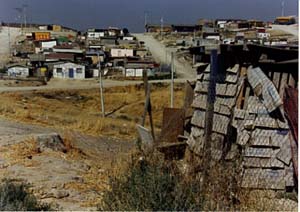 |
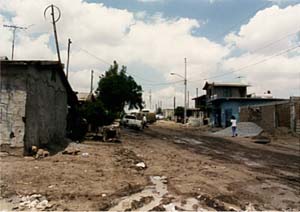 |
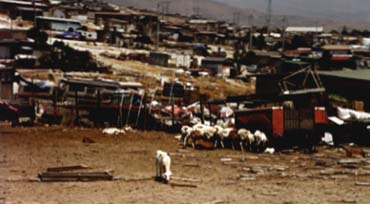 |
|
She used to hate the US and its people with a passion. It took her coming here to get rid of her anger, to see that all Americans are not bad, self-righteous, and self-centered people. Here she meets many who have come to learn more about Mexicans and to try to help the impoverished of the city, bringing clothing, houses, and other items for donation. She continues to hate US foreign policy though, and it's hard to think who wouldn't. I disapprove of a lot of what the US government does, and most of the history of the US, up until this very day, makes me ill. Conquering, slavery, racism, Manifest Destiny, the US-Mexican War, the Indian campaigns, immigration policy and isolationism, the Atomic bomb, the Cold War, the Communist scare, separate but equal, the Vietnam war, oppression of speakers of conscience, support of death and dictatorship abroad, violation of human rights at home and abroad, and on and on. The history is the history of a barbarous and racist people. Most countries have histories which document as much of their own peoples. We must move on to the next stage of history, and demonstrate for the first time that we are humans and not animals. |
|
 |
 |
Home
Copyright (C) 1999-2003 Rachael Rapp. All rights reserved. |
|
 rowing up in Colorado, I never needed to look very hard to find Mexican nationals, Latinos, or traces of Mexican influence in the region. I became interested in Mexican topics early on, and the closer I got the more I was pulled in to the fascinating story that has unfolded until today. It's a complex story of history, politics, economics, and society.
rowing up in Colorado, I never needed to look very hard to find Mexican nationals, Latinos, or traces of Mexican influence in the region. I became interested in Mexican topics early on, and the closer I got the more I was pulled in to the fascinating story that has unfolded until today. It's a complex story of history, politics, economics, and society.
